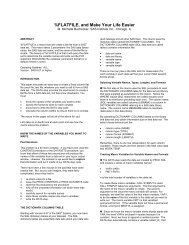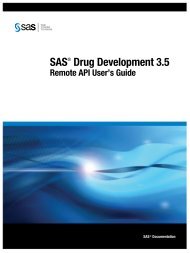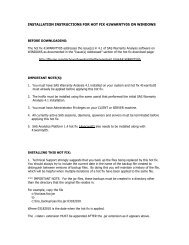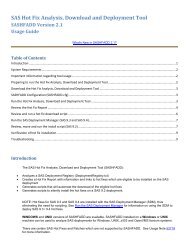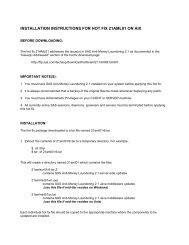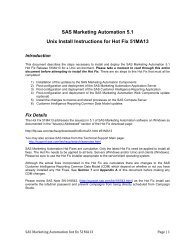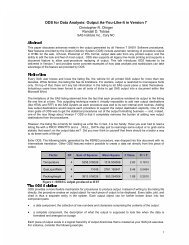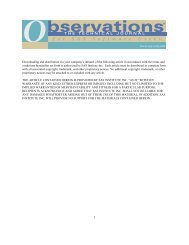SAS 9.3 Web Applications: Clustering - Index of - SAS
SAS 9.3 Web Applications: Clustering - Index of - SAS
SAS 9.3 Web Applications: Clustering - Index of - SAS
Create successful ePaper yourself
Turn your PDF publications into a flip-book with our unique Google optimized e-Paper software.
46 Chapter 5 / IBM <strong>Web</strong>Sphere Application Server 7.0 <strong>Clustering</strong><br />
Add Additional Machines<br />
If the <strong>SAS</strong> <strong>Web</strong> applications will be deployed to application server instances on<br />
additional machines, then see <strong>Web</strong>Sphere Application Server documentation for<br />
information about adding nodes to the cell.<br />
Create a Server Template from <strong>SAS</strong>Server1<br />
When the <strong>SAS</strong> Deployment Wizard is used to configure <strong>Web</strong>Sphere Application<br />
Server, an application server, <strong>SAS</strong>Server1, is configured with all the resources that<br />
are needed by the <strong>SAS</strong> <strong>Web</strong> applications. This task describes how to use<br />
<strong>SAS</strong>Server1 as a server template to reduce the effort that is required to configure<br />
additional servers for the <strong>SAS</strong> <strong>Web</strong> applications and the cluster. Follow these steps:<br />
1 Select Servers � Server Types � <strong>Web</strong>Sphere application servers. Click<br />
Templates and then click New.<br />
2 Select the radio button for <strong>SAS</strong>Server1 and click OK.<br />
3 Provide a name, such as <strong>SAS</strong>ServerTemplate, and a description. Click OK.<br />
Create the Cluster and Add Servers<br />
To create a cluster and add servers to it, follow these steps:<br />
1 Select Servers � Clusters � <strong>Web</strong>Sphere application server clusters and<br />
click New.<br />
2 Provide a name, such as <strong>SAS</strong>Cluster, and make sure that the Prefer local and<br />
the HTTP session memory-to-memory replication check boxes are cleared.<br />
Click Next.<br />
Note: <strong>SAS</strong> <strong>Web</strong> applications do not use Enterprise Java Beans, and do not<br />
support session-level failover.<br />
3 On the Create first cluster member page, select Create the member using an<br />
application server template, and then select <strong>SAS</strong>ServerTemplate. Click Next.<br />
4 You can add server instances to the cluster. To add a server, provide the<br />
member name, and make sure that Generic Unique HTTP Ports is selected.<br />
Click Add Member.<br />
5 Click Finish and then save the changes to the master configuration.





